Monuments in the Desert: A Note on Economic and Social Roots of the Development of Buddhism along the Silk Road
Connie Chin
Stanford University
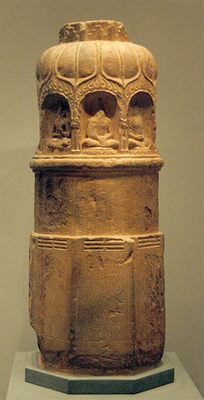
Fig. 1. Votive pilla, Qocho Ruin E
(MIK III 6838). Museum für Indische
Kunst, Staatliche Museen Preussischer
Kulturbesitz, Berlin.
Photograph © Daniel C. Waugh 2004.
o develop into a social institution, a religion must have economic as well as religious roots. This paper will discuss material, much of it found at Dunhuang, which demonstrates the economic base on which the Buddhist religion grew and became an integral part of life along the Silk Road. Along the way it was flavored by diverse ethnic groups, languages, and gender relations, as is revealed in the archaeological, art, and documentary evidence.
Beginning as a reaction against Hinduism and rejecting attachment to all things, Buddhism, paradoxically, spread along the routes of commerce and began to develop into a facet of urban, commercial culture in the Kushan empire, that covered a territory which is now northern India, western Pakistan, and Afghanistan. During the transition to Mahayana Buddhism in the Kushan area, the Buddha began to take on supernatural power; thus worshipping relics of the Buddha could bring blessings to the faithful. Stupas built to contain the Buddha’s relics spread across northern India. Though the monks in these days were forbidden to worship relics, the laity was encouraged to pay for the construction of stupas and their decoration, as well as for the fundamental requirement to provide food and housing for the monks.
Some Mahayana scriptures, such as the Mahavastu, claimed that worship of and donations to a Buddha offered tangible benefits. For example, a king who built a palace full of precious things for the Buddha could claim Buddhahood from this act of merit. In this text, the main items used in honoring a Buddha consisted of the exotic merchandise later traded extensively along the Silk Road: pearls, coral, lapis lazuli, and other precious substances were used as religious gifts [Liu 1988, p. 93]. The decoration of Buddhist monuments with silk was encouraged by the Mahavastu as well, leading believers to decorate stupas with thousands of silk banners. The items most valued in society changed to include the seven treasures needed for Buddhist worship. The worship of bodhisattvas, future buddhas who could use their accumulated merit to help the faithful, by extension implied that merit, like goods, could be transferred to others or exchanged for good deeds or donations.
Buddhism had spread rapidly across the trade routes all the way to China by the Han Dynasty. In the first century, however, Buddhist communities seem to have been mostly foreign families dwelling in urban centers. By the second century CE, missionaries were translating the sutras in Luoyang. The noted translatormonk Dharmaraksha’s ancestors were Yuezhi people who had immigrated to Dunhuang a few generations before. The Parthian merchant An Xuan joined An Shigao, a monk, in translating the sutras, a reminder of the commercial nature of the foreign community and the close relationship between Buddhist missionaries and merchants [Liu 1988, p. 140]. The Parthians, Yuezhi and Indians mentioned from this time probably all came from Kushana and followed the commercial routes through Central Asia into China.
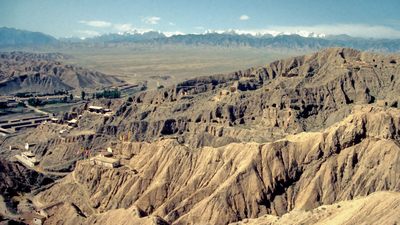
Fig. 2. Wenshushan. Photograph © Daniel C. Waugh 1998.
Construction of Buddhist caves and statues increased during the third and fourth centuries, reaching its peak during the Northern dynasties. There is a historical record of cave cutting in 397 CE in Liangzhou, and the Dunhuang caves were started in the fourth or fifth century. The first caves were sponsored by the Former Liang, a dynasty that administered a vast territory from the Hexi corridor, beyond Dunhuang, stretching into Gaochang (Turfan). In this area resided diverse peoples, including Han, the Turkic Xiongnu and Xianbei, Jie (who were perhaps Indoscythians), Qing and Di, who were related to Tibetans and Tanguts [Howard 2000, p. 242]. As stations along the Silk Road, the Former Liang cities were places where differing cultures interacted.
There are fourteen votive pillars dating to the Liang period which portray the synthesis of Daoism, Confucianism, and Buddhism that developed in the third century. For example, one artifact [analogous to that in Fig. 1 (p. 8) but not shown here], was donated by a patron named Gao Shanmu and dated 428 CE. It has several sections, with a bottom frieze showing four males and four females; incised above each is a trigram from the Yijing, a Confucian text. The writing above that is an early Buddhist text, the Ekottaragma sutra. Above that is a band of Buddhas, and it is topped by the constellation of the Dipper (a Daoist symbol) on its rounded summit [Howard 2000, p. 255; Juliano and Lerner 2001, pp. 152-155].
This cultural melding is reflected in some of the earliest caves. Wenshushan [Fig. 2] in Hexi and later, Cave 285 at Dunhuang, include cells on the sides, which were likely used as meditation enclosures similar to the Indian site at Ajanta. Syncretic Daoist, Indian, and Buddhist themes crowd Western Wei Cave 285, which is dated 538 and 539 CE. On the ceiling, a central jewel is flanked by serpentine beings, one holding a builder’s square (Fuxi) and the other a compass (Nuwa), early Chinese deities [Fig. 3]. Thunder gods, birds and phoenixes, some with Daoist immortals riding them, sweep across the ceiling. Indian deities, including Siva, Vishnu and Ganesa, flank the main Buddha niche on the west wall. The dated inscriptions on the wall are flanked on the right by male donors in Tuoba Xianbeistyle clothing, and on the left, by women in long, striped skirts, with larger figures of monks [Whitfield 1995, p. 42].
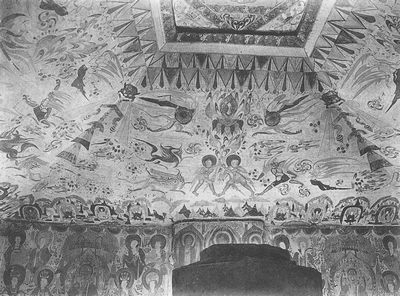
Fig. 3. East slope of ceiling of Mogao Cave 285, photographed in 1908
by Charles Nouette. Source: Mission Pelliot en Asie Centrale. Les
Grottes de Touen-Houang (Paris: Geuthner, 1914; facsimile ed. 1997).
As time went on, Buddhism became more and more integrated into Chinese society. Although there was a brief period of persecution, in the Northern Wei dynasty, the Xianbei rulers used Buddhism to lend themselves legitimacy. Buddhist institutions, in turn, garnered political and economic support from the Northern Wei emperors. Much Buddhist building activity took place. The Northern Wei emperors honored Buddhist teachers as they tried to control them. Emperor Dao Wu appointed Faguo as Head of Monks, and Faguo responded by calling the emperor the modernday Buddha. The rulers and the monasteries generally lived in harmony because the Buddhists submitted to the government. As the years passed, the number of monks and monasteries began to increase, and the Wei rulers found it difficult to rein them in. In the early 460s a monk from Liangzhou named Tan Yao became Head of Monks. He began the excavation of the earliest caves at Yungang, and had five gigantic statues of Buddha carved out of the cliff, thought now to represent the five emperors of the Northern Wei as incarnations of the Buddha. He requested permission from the Wei emperor to take war captives from Shandong as tenants for Buddhist monasteries, and called them “sangha households.” Each of these households paid “sangha grain” to the local office of monks. Tan Yao also asked to convert some criminals and slaves to “Buddha households,” whose members cleaned or cultivated land for the monasteries [Wei Shou, tr. Hurvitz 1956, p. 73].
Emperors and empressdowagers patronized Buddhism by building monasteries and conducting ceremonies. The first monastery built by the Northern Wei rulers was the Yungningsi in Pingcheng in 476 CE, a landmark of the capital city with its sevenstory stupa. Princes of the royal family contributed the largest amount of money for monastery construction. In the Northern Wei capital of Luoyang, some residences were changed posthumously into monasteries. The many royal widows and concubines were sequestered in nunneries when the princes or rulers died, a frequent occurrence due to the constant warfare of the time. Government ministers, eunuchs, and even the imperial guards built monasteries. Of six monasteries built by eunuchs in Luoyang, five were nunneries [Yang, tr. Jenner 1981, p. 231].
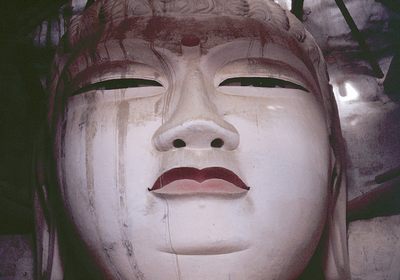
Fig.4. Head of the Maitreya Buddha of Mogao Cave 96.
Photograph © Tese Neighbor.
The adoption of Buddhism in China opened up new roles for women. Traditionally confined to the roles of daughter, wife, mother, and mother-in-law, women were offered in Buddhist institutions new alternatives outside family life. In Buddhist nunneries women could be educated to read and copy sutras, to manage businesses and keep accounts, as well as fulfill their primary duty of worship and meditation. As Yang Hsuan-chih describes the Hu-tung Nunnery (Nunnery of the Chief of Tuoba Monks) founded by the aunt of the Northern Wei empress dowager Wenming, “The nuns here were among the most renowned and accomplished in the imperial city, skillful at preaching and discussing Buddhist principles. They often came to the palace to lecture on Dharma for the empress dowager, whose patronage of Buddhists and laymen was without equal” [Yang, tr. Wang 1984, p. 56].
The de facto ruler of the Northern Wei dynasty at the time Buddhism became a state religion was Empress Dowager Wenming, who was Chinese. Empress Dowager Wenming was the driving force behind the imperial chapels at Yungang. A later Empress Dowager, Lady Ling, was a central figure in Northern Wei court politics, from making policies to appointing officials. She also was a lavish benefactor of Buddhism before a coup resulted in her being thrown into the Yellow River and drowned. Of course, the greatest woman ruler in China was Empress Wu Zetian. During her rule in the Tang dynasty, the largest Buddha statue in Dunhuang, which faces the visitor upon approaching the Mogao caves, was constructed [Fig. 4]. This 99-foot high image of the future Buddha Maitreya reveals a woman’s bodily form and clothing [Fig. 5; Ning 2004, p. 115]. Ning Qiang has argued that Cave 96, containing the huge sculpture, is a local confirmation about the legitimacy of the rule of Wu Zitian and an example of how social and political issues were addressed through religious art.
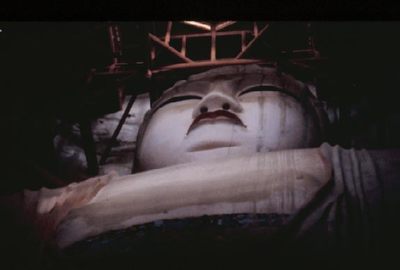
Fig. 5. The Maitreya Buddha of Mogao Cave 96, from below.
Photograph © Tese Neighbor.
Basing their activities on the Indian models of the Kushan state, the monks of the Northern Wei dynasty spent their time encouraging donations and conducting rituals. Faxian and other Chinese pilgrims witnessed Buddhist ceremonies in India, visited monumental buildings dating back to the Kushan king Kanishka, and carried Buddhist writings back to China. The information they brought back encouraged Chinese Buddhists to finance rituals, cave temples, and statues.
The Buddhist monasteries launched a large-scale votary movement. The Northern Wei donors expected to receive benefits for their future lives and for their deceased relatives in return for their donations. One of the favorite subjects of murals was the Tushita heaven, or the Western Land of Bliss of Amitabha, themes that are common subjects in cave art of the time. From a study of dated inscriptions of the Northern dynasties, we find the most common expected beneficiaries were the donor’s direct relatives, especially parents. The second group of primary beneficiaries was emperors, and other statues were dedicated to empress-dowagers, court officials, local administrators, religious teachers, and lay associations. While the royal family and ministers and officials patronized the large-scale construction, in one study it appears that common people donated 48% of the statues, followed by monks and nuns (19.7%) and donors’ collectives (18.9%) [Sato Chisui, “Study of Votive Inscriptions on Buddhist Statues in the Northern Dynasties,” cited in Liu 1988, p. 163].The Buddhist associations were organized to collect donations. Some associations had strong family and territorial ties, while some appeared to be urban-based groups, but they seem to have incorporated several social strata in their ranks.
Buddhist institutions played a role in social activities, such as festivals, and were widely supported by the society. A description of a Buddha’s Birthday celebration in Northern Wei depicts a thousand images from various monasteries paraded through the streets of Luoyang, attracting large crowds as they competed in splendor with each other [Yang, tr. Wang 1984, p. 46]. The golden carriage of Jingxing nunnery was covered by a canopy hung with golden bells and beads of the seven treasures, so valuable that the imperial guards were called upon to carry it. As the parade of images stopped at the gate of the palace, the emperor bestowed flowers upon them. Acrobats and dancers accompanied the images, as the people emptied out the marketplaces in order to see the parade.
Monasteries had received land from donors as early as 420 CE, when an official named Fan Tai built the Qihuan Monastery and donated sixty mou (about .14 acre) of fruit and bamboo groves for its upkeep [Gaosengzhuan 7, T 50.368c, in Ch’en 1973, p. 126]. The Sui Emperor Wen donated 100 qing (one qing equals 100 mou, or about 14 acres) of land to the Shaolin Monastery at the foot of sacred Mt. Song [Chin-shih ts’uipien, 77.16b, in Ch’en 1973, p. 126]. The monks themselves were forbidden to till the land [Pai-chang ch’ing-kuei, Record Sayings, in Ch’en 1973, p. 148].1 The Buddhist Vinaya, Rules of Discipline, prohibits farming by monks, on the grounds that farming harms living things in the earth, and even watering plants harms life contained in the water. This meant that in most cases cultivation was done by tenant farmers or temple slaves, sometimes called qing ren, or “pure people” because they spared the monks the impure tasks of farming, handling gold and silver, and trading in goods.
In the early part of the Northern Wei dynasty, the local monasteries at Dunhuang must have been modest and rather inconspicuous [Soper 1958, p. 157]. Dunhuang was not yet a great pilgrimage center, and the monks must have toiled away at their tasks in relative isolation, a few miles south of the great eastwest trade route of the Silk Road. However, by the mid-Tang dynasty, as elsewhere in China where Buddhist institutions controlled so much land that they were regularly attacked in memorials to the throne as parasites on society, the Dunhuang monasteries had become an important part of the local economy, owning land, lending money, and operating grain mills and oil presses.
Documents from the famous Library Cave of Dunhuang, carried off by Marc Aurel Stein and Paul Pelliot to Europe, demonstrate the role that Buddhist institutions played in the Dunhuang economy. For example, there is evidence that monks and nuns owned and bought property, including slaves. A contract from the Library Cave [Pelliot 1297, in Wang 1983, p. 59, tr. Ernest and Connie Chin] reads,
Mazhu (owner of the horse) thumb print
Ying nuo ren (purchaser) thumb print
Yadengsu Zan official seal
A legal dispute about a young slave named Li Yang Bei showed that he was also purchased for five ounces of silver [Pelliot 1081, in Wang 1983, p. 48]. While lengths of cloth, grain, and oil were the currency used for lesser purchases, apparently horses and people were bought with silver.
Another legal document depicts a lawsuit against a nun, in which intergenerational tensions are revealed as much as a property rights dispute [Pelliot 1080, in Wang 1983, p. 48, tr. Ernest and Connie Chin]:
“In the past, in the Year of the Rabbit, near two tribes, Yufanbo and Tuihun, many people suffered from cold and hunger, waiting to die. When it was snowing in the city of Shazhou, a poor person carrying a bundled up one year old baby came to my door and said, ‘The baby’s mother has died and I have no strength to raise her. She will die in a few more days. You can take her as your adopted daughter or take her as a female slave, either is all right.’ Out of pity I adopted her. Like a twinkling of an eye, twenty years have passed. The girl is now twenty-one. Now, because of [?], the Kung family has instigated the girl’s changing her mind and she has threatened me, saying, ‘My maternal uncle is Ni Baitso.’ A woman came from the Tongjia Yamen [office concerned with matters between Han and tribal peoples], and the girl claimed it was her mother. They talked like people insane. The girl also was not keen on working as hard as before. Because of this I appeal to you to render judgment that the girl belongs to me as designated by the agreement. No one will be able to ask for her, and no one should do harm. I earnestly ask you to issue an order with the official seal.”
Instruction: “According to the adoption agreement, she is not free to select a master. She must follow the original agreement.”
Because of the availability of scribes and the moral authority lent to contracts signed there, temples in the ancient world were a main site for writing contracts, exchanging money, and lending money. This was true in Greek temples, the temple in Jerusalem, and in Buddhist monasteries. The Mahasanghikavinaya sutra justifies this kind of commercial activity, saying that if goods donated to the sangha were not consumed by the monks and nuns, the surplus could be sold or loaned out to earn a profit, to be used to support the sangha and Buddhist facilities.
This was the scriptural basis of the wu-jin-tsang, or “Inexhaustible Treasury,” a kind of Buddhist savings bank of donations by the faithful which became a flourishing commercial institution in the Tang dynasty. The revenues of the Inexhaustible Treasury were used to repair Buddhist temples and monasteries, to relieve the sufferings of the poor, and for offerings to the Buddha [Taiping kuang-chi, 493.4047 (Peking 1959), in Ch’en, 1973, p. 163].
Many documents from the Library Cave at Dunhuang give details about commercial transactions at the monasteries. Examples are a contract for the loan of beans, with an interest rate of 50%, and a contract for a loan of silk, with a default penalty, which was double the amount borrowed [Stein 1475 and Pelliot 3004 and 3472, cited in Ch’en 1973, pp. 165-167]. Perhaps, as in central China, the Dunhuang monasteries served as pawnbrokers, or repositories where local patrons could keep their wealth. One document from the British Library Dunhuang Archives website is an inventory of cloth and grain, perhaps of donations. Part of it says [Fig. 6; IDP, BL Or. 8210/S.5691/R.1, tr. Ernest and Connie Chin]:
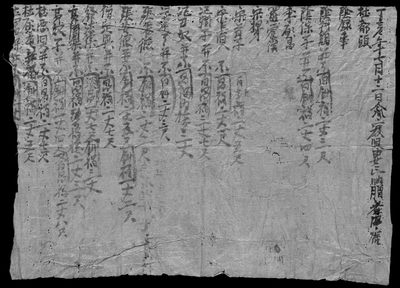
Fig. 6. Account Note, BL Or. 8210/S.5691/R.1.
Photograph © The British Library, used with permission.
All rights reserved.
| Zhang Yangde | presents | diagonal weave coarse wool cloth, 2 zhang 2 chi |
| Zhang Ande | total presents | diagonal weave coarse wool cloth, 2 zhang 5 chi diagonal weave coarse wool cloth, 1 zhang 2 chi |
| Monk Dingxing | total presents |
Gaocheng coarse wool, 2 zhang 7 chi.2 |
Early industrial projects were carried out either by rich and powerful families or by monasteries, which had access to the large amounts of capital which were required. One of the most profitable and widespread enterprises was the waterpowered mill, or nien wei, which ground grain to produce flour.
Several Dunhuang documents are accountants’ reports on income derived from mills owned by local monasteries.3 For a ten-year period between 924 and 945 CE, Pelliot manuscripts 2032, 2040, 2049 and 3234 show rent earned by Qingtu Monastery from its milling installations yielded more than 60 shih of flour annually [Gernet 1995, p.146].4 In addition, it received 18 shih of bran used as feed for horses and 5-18 shih of coarse flour (tsu mien) that the gauze sieves had not allowed to pass, which was used to feed the female workforce at the monastery [Gernet 1995, p. 355].5 Gernet estimates that half of this amount would have provided the needs of the religious community at Qingtu with its population of fifty to seventy monks at that time.
The flour was also used as a medium of exchange and sold to the laity. The monasteries had to pay artisans, hold banquets for officials and lay associations, and provide for monks traveling through the region. There were many feast days on the Buddhist calendar, which involved not a trivial amount of expense.
The mills were owned by the monasteries, but maintained by professional millwrights. Banquets, to which the millwrights were invited, celebrated the end of repair work and opening of the sluice gates. A document from Anguo nunnery shows the accounts of the abbess for the year 886, including expenditures of .3 shih of millet, .5 sheng of oil, and .1 shih of wheat for a banquet on the occasion of the opening of the sluice gates [Pelliot 3107, in Gernet 1995, p.147].
Oil presses at Dunhuang were another source of income for the religious communities. Oil was one of the most precious commodities, much in demand for lamps burning in the Buddha Hall, illuminations that frequently took place at the monasteries, and for cooking. In addition, oil served as currency. According to documents from Dunhuang, one Chinese liter of oil was worth 30 chi (feet) of cloth. A foot of cloth was worth six liters of cereals, so the value of a liter of oil was approximately 180 liters of millet or wheat [Gernet 1995, p. 355]. The oil presses were operated by specialized households, which paid the monasteries rent spelled out in contracts [Pelliot 2032, 2040, 2049, 3234, in Gernet 1995, p. 355]. An example of expenditures denominated in oil comes from Pelliot 3234: .0015 shih for a quilted gown and a meal; .05 shih of oil for the sculptorartisan Ling Hu and workers who coated the walls [Gernet 1995, p. 151].
Cave 317 at Dunhuang (Middle Tang, 825-830 CE) has a lovely wall mural showing these commodities as used in daily life in the courtyard of a m o n a s t e r y [Whitfield 1995: Vol. 1, p. 214]. At the back of the courtyard is a Buddha figure with bodhisattvas on either side. Two monks sit in the corners, one reading from a sutra. In the middle of the courtyard a long silk banner flies from a pole, and a monk stands beneath the banner reaching up to place an oil lamp on a fivewheeled candelabra, preparing for an illumination. A huge amount of food, including noodles and flat cakes, is piled on a large table to one side, attended by laymen carrying bowls. The people in the mural are probably preparing for a vegetarian feast, one of the activities sponsored several times a month by lay organizations.
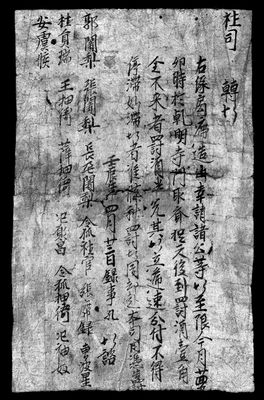
Fig. 7. “Club circular,” BL Or.8210/S.6066/R.1.
Photograph © The British Library, used
with permission. All rights reserved.
The Buddhist lay associations were attached to monasteries and assisted in various programs to spread the religion among the populace. They helped organize and fund the numerous festivals, often centered around popular sutra lectures by eloquent monks. The Dunhuang manuscripts are replete with papers and fragments which contain information on the lay societies and their activities. A whole category of manuscripts on the British Museum’s Dunhuang Archives website is devoted to this type of material, which they label “club circulars.” A typical one reads [Fig. 7; IDP, BL Or. 8210/S.6066/ R.1, tr. Ernest and Connie Chin]:
Ren Zhen Year, 4th month, 23rd
day
Clerk Kung
Notice copied to 13 names
listed.
Another such notice was sent to the membership of a lay association on the occasion of Buddha’s Birthday [IDP, BL Or.8210/S.5813/R.1, tr. Ernest and Connie Chin]:
Second month. Buddha’s Birthday Celebration. From officer in charge of the association, Kung Zi Sheng: On the 20th day of this month before evening, deliver one dou and five sheng of wheat and two sheng of millet. This notice must be immediately circulated
and must not stop or you will
be fined.
Signed
She Guan (officer of
association), Song
She Zhang (officer of
association), Zhang.
Both Song and Zhang have initialed it with the word zhi “acknowledged.” ![]()
Most lay supporters, of course, were ordinary people. One document in the British Library describes a society of fifteen Buddhist women founded by a nun for the promotion of friendship among women [Stein 527, in Ch’en 1973, p. 288]. Dated 959, the document opens with a statement that
On feast days, members were required to contribute oil, wine, and flour.
The document adds that, having joined the group, a member would be bambooed three times if she wished to leave, and forced to give a feast for the others.
Indeed, it is striking how many women donors appear in wall murals in the caves. Often there are as many women donors depicted as there are men. Women appear in nomad dress in the earlier caves, and in Chinese dress in some later caves. They are both lay and monastic, wealthy and ordinary people.
The Buddhist peoples of Inner Asia and China, like the Greeks and Romans, early Christians and many others, apparently also felt the need for a female deity or deities. The most important feminine icon, the boddhisattva Avalokitesvara, or Guanyin, was transformed from a male to a female on the long trip along the Silk Road and over the centuries. Two Tang Caves at Dunhuang, 45 and 194, show the Boddhisattva’s different genders. In Cave 45 [Fig. 8] Avalokitesvara is male, protecting a merchant caravan “carrying valuable treasures by a precipitous road in an infinity of lands full of bandits” [Cartouche quoting the Lotus Sutra in the wall painting in Cave 45, tr. Whitfield 1995: Vol. II, p. 316]. In Cave 194 Avalokitesvara is depicted as the epitome of plump female beauty, arrayed in the most elegant of High Tang feminine apparel, with only a faint green moustache showing the transition from the other gender. Thus the bodhisattva of mercy not only appealed to women, but became a woman.
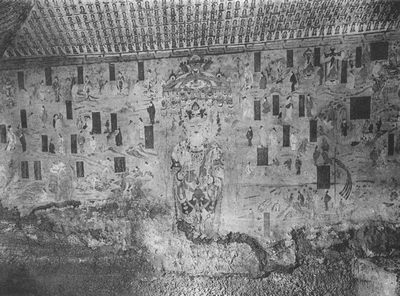
Fig. 8. Avalokitesvara with scenes of the bodhisattva’s miraculous
intervention, illustrating the Lotus Sutra. Dunhuang Mogao Cave 45,
photographed in 1908 by Charles Nouette. Source: Mission Pelliot en
Asie Centrale. Les Grottes de Touen-Houang (Paris: Geuthner, 1914;
facsimile ed. 1997).
This is just one of many aspects of a changing society depicted in the thousand-year history of Buddhist grottoes along the Silk Road. In the material from Dunhuang we can trace the symbiotic development of the Buddhist religion and economic and political changes that occurred along the nearby trade routes over the centuries. Buddhist teachings affected what was carried along the Silk Road. These trade goods include precious stones and silk banners used in worship, and minerals used in Buddhist art. Rulers used Buddhist tenets to acquire legitimacy for themselves, and Buddhist institutions flourished under their patronage, becoming an integral part of society and economy. People from all walks of life were involved in Buddhist institutions, participating in rituals, donating goods and time, and enjoying feast days. Many women took part, and developed in roles outside the family as Buddhist institutions granted new spaces for them in society. Acts of Buddhist devotion, patronage, and politics caused works of great art to be created and sustained, finally to be left buried in desert sand, a panoramic fusion of the cultures of many peoples who lived and traveled along the Silk Road.
About the Author
Connie Chin works at the Center for East Asian Studies at Stanford University. A graduate of Oberlin College, she studied Chinese at Chinese University of Hong Kong while writing for the South China Morning Post. She also taught English at Tunghai University in Taiwan, where she began to study classical Chinese. She is intrigued by Silk Road cultures and loves to read early Chinese history. E-mail: csquare@stanford.edu.
References
- Ch’en 1973
Kenneth K.S. Ch’en. The Chinese Transformation of Buddhism. Princeton, N.J.: Princeton University Press, 1973. - Gernet 1995
Jacques Gernet. Buddhism in Chinese Society: An Economic History from the Fifth to the Tenth Centuries. Tr. Franciscus Verellen. New York: Columbia University Press, 1995. - Howard 2000
Angela Howard. “Liang Patronage of Buddhist Art in the Gansu Corridor.” In Wu Hung, ed. Between Han and Tang: Religious Art and Archaeology in a Transformative Period. Beijing: Cultural Relics Publishing House, 2000, pp. 239-242. - International Dunhuang Project
International Dunhuang Project, British Library. http://idp.bl.uk. - Juliano and Lerner 2001
Annette L. Juliano and Judith A. Lerner, eds. Monks and Merchants: Silk Road Treasures from Northwest China. Gansu and Ningxia, 4th-7th Century. New York: Abrams; Asia Society, 2001. - Liu 1988
Xinru Liu. Ancient India and Ancient China: Trade and Religious Exchanges A.D. 1-600. Delhi: Oxford University Press, 1988. - Ning 2004
Qiang Ning. Art, Religion, and Politics in Medieval China. Honolulu: University of Hawai’i Press, 2004. - Soper 1958
Alexander Soper. “Northern Liang and Northern Wei in Kansu.” Artibus Asiae, 21 (1958): 131-164. - Wang 1983
Wang Yaoqian. Dunhuang Tufan Wenxian Xuan Chengdu : Sichuan Minzu Publishing
House, 1983.
: Sichuan Minzu Publishing
House, 1983. - Wei Shou, trans. Hurvitz 1956
Wei Shou. 506-572. Treatise on Buddhism and Taoism. English translation by Leon Hurvitz, Appendix II to an English translation of the original Chinese text of Wei Shu CXIV and the Japanese annotation of Tsukamoto Zenryu (repr. from Yun-Kang, The Buddhist Cave Temples of the Fifty Century A.D. in North China, vol. xvi, supplement). Kyoto, 1956. - Whitfield 1995
Roderick Whitfield and Seigo Otsuka. Caves of the Singing Sands: Dunhuang: Buddhist Art from the Silk Road. 2 vols. London: Textile and Art Publications, 1995. - Yang, trans. Jenner 1981
W.F.J. Jenner, trans. Memories of Loyang: Yang Hsuan-chih and the Lost Capital (493-534). Oxford: Clarendon Press, 1981. - Yang, trans. Wang 1984
Yang Hsuan-chih. 547. Translated by Wang, Yi-t’ung. A Record of Buddhist Monasteries in Lo-Yang. Princeton, N.J.: Princeton University Press, 1984.
